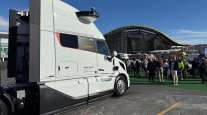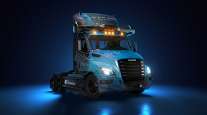Managing Editor, Features and Multimedia
Torc Lays Out Road Map to Autonomous Truck Launch in 2027

[Stay on top of transportation news: Get TTNews in your inbox.]
ALBUQUERQUE, N.M. — Self-driving truck developer Torc Robotics is fine-tuning its technology and laying the foundation for autonomous fleet operations as it targets a 2027 market launch for its virtual driver product.
The independent subsidiary of Daimler Truck is paving the way for that rollout by conducting pilots with major motor carriers and mapping out the details of how fleet customers will dispatch and monitor unmanned commercial vehicles in the coming years.
Torc outlined its commercialization plans and showcased its progress during ride-along demonstrations in its self-driving prototypes during a Nov. 13-14 press event at its Albuquerque research and development center.
Torc CEO Peter Vaughan Schmidt said autonomous trucks will enable fleets to transport freight “faster, safer and at a lower cost” while also helping to alleviate their long-standing driver recruiting and retention challenges.

Who's Who in the Autonomous Space
►Overview of Self-Driving Truck Development
Company Sketches
Click the links to jump to profiles of autonomous companies.
Aurora | Waymo | TuSimple | Gatik | Locomation | Torc Robotics | Waabi | Einride | Plus | Embark | Kodiak Robotics | Robotic Research | Outrider | Pronto
By automating stretches of highway driving between designated freight hubs, autonomous trucks could shift more driver jobs toward local and regional routes that offer more home time and typically have lower turnover rates.
“This technology really has the potential to address this pain point, to drive down cost, to make goods arrive faster,” Schmidt said. “This can do good things for fleets but also for society.”
He suggested the barrier to entry for autonomous trucking will be relatively low. While the truck itself will be more expensive, the cost per mile will go down significantly.
“If you buy an autonomous truck, the payback time will be less than a year,” Schmidt said.
Torc’s virtual driver will be available with a modified version of the Freightliner Cascadia with redundant systems and components designed specifically to support autonomous driving.
In the years since Daimler acquired a majority stake in the company in 2019, Torc has not veered from its vision of unmanned trucks traveling between designated hubs on interstate highway routes as the first step for autonomous trucking.

Buttler
“We are staying laser focused on U.S. hub-to-hub, on-highway,” said Joanna Buttler, head of Daimler Truck’s global autonomous technology group.
Although this business model requires strategically located freight hubs to serve as launching and landing points for autonomous trucks, those hubs won’t necessarily require massive investments in new infrastructure.
Instead, fleets could adapt or remodel existing terminals, distribution centers or warehouses located near interstate highways on high-volume freight lanes to serve as autonomous truck hubs, Schmidt said.
While the hub-to-hub model is designed to reduce complexity by minimizing off-highway driving, unmanned trucks still will need to safely handle difficult driving conditions they may encounter on the road.
During a 30-minute ride-along demonstration, Torc’s autonomous driving system navigated situations that can be challenging for professional drivers.

Torc’s virtual driver will be available with a modified version of the Freightliner Cascadia with redundant systems and components designed specifically to support autonomous driving. (Torc Robotics)
The 16-mile route, primarily on Interstates 25 and 40, incorporated many lane changes in moderate to heavy traffic, as well as a cloverleaf interchange and an intersection with a stoplight and crosswalk.
Torc’s prototype autonomous truck, a Freightliner Cascadia equipped with automated driving software and sensors, negotiated traffic while hauling a loaded trailer and traveling at highway speeds just under the posted speed limit of 65 mph.
The virtual driver waited for opportune times to complete lane changes based on traffic in the neighboring lanes and automatically created and maintained a safe following distance when a pickup truck cut in front of it.
Along the way, the autonomous driving system monitored and identified other vehicles on the road as well as a passenger car broken down on the shoulder.
As is the case in all of Torc’s testing on public roads, the self-driving truck had a safety driver behind the wheel and an autonomous vehicle specialist known as a “safety conductor” in the passenger seat.
The safety driver drove the truck manually from Torc’s research center to I-25, then activated the virtual driver while merging onto the highway. From that point on, the truck operated autonomously with no driver input for the remainder of the run until the safety driver resumed manual control while exiting the highway to return to the research facility.

Culhane
To move beyond the testing and development phase and prepare for commercialization at scale, Torc will bring its technology to market in stages and gradually expand its network of supported routes, said Andrew Culhane, Torc’s chief strategy officer.
“We look at rollout in a phased approach,” he said.
Culhane said Torc will begin by removing the safety driver on an initial freight lane in Texas between Laredo and Dallas to prove the economic viability of its autonomous trucks. This north-south route covers about 400 miles and aligns with freight volumes generated by the ongoing nearshoring of production to Mexico from overseas markets.
At first, Torc will own the autonomous trucks and hubs on this first lane and manage everything from operations to maintenance. Over time, however, the company will transition to a model where its customers own and manage self-driving vehicles themselves while fleet operators or other third-party partners own and operate autonomous truck hubs.
After establishing the Laredo-Dallas lane, Torc plans to expand its network to routes along I-40 and connect with key market areas including Phoenix, Albuquerque, Oklahoma City, St. Louis, Memphis, Tenn., and Atlanta. The next phase of development would add regional expansions to El Paso, Texas; Houston, and Shreveport, La.
Torc also outlined a set of specialized job functions to support hub-to-hub autonomous truck operations.
A “hub operator” will handle physical tasks involving the autonomous truck such as conducting pre-trip safety inspections, refueling, hooking the truck to the trailer and driving it into position for launch.
When the truck is ready, a “mission manager” will dispatch and remotely monitor autonomous trucks as they transport freight. Torc said it plans to develop integrations with fleets’ existing transportation management systems to support this mission control function.
Autonomous trucks also will involve new responsibilities and training for maintenance technicians, roadside assistance and customer support.
In the meantime, Torc already has been using its test fleet to haul freight through pilot projects with major trucking companies such as Schneider and C.R. England.

Schmidt
Schmidt highlighted a pilot run from Phoenix to Oklahoma that spans about 1,000 miles with the truck arriving “with the last drip of diesel.”
Torc’s autonomous advisory council, consisting of major carriers, freight brokers, maintenance providers and other industry stakeholders, has provided guidance to the company on how best to integrate its technology into real-world freight networks.
At its last meeting, the members of that council represented $90 billion in freight, Schmidt said.
“I’m not at all worried about commercial traction,” he said. “We are shaping the future together with them.”
Want more news? Listen to today's daily briefing below or go here for more info:




